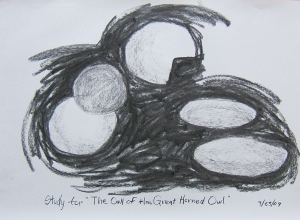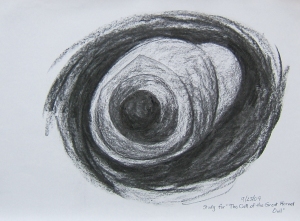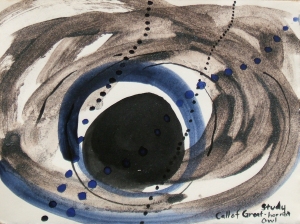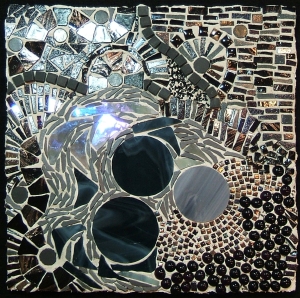Hatching an Owl
For those who are wondering about a way to get a mosaic started, here is a train of thought… I knew I wanted to make an abstract mosaic of the hooting of a Great Horned Owl (see entry “Sounds in the Dark” from October 1) . First, I listened to a recording of the owl several times. Then, I got a large sheet of white paper and put it on an easel so that I could see it from a distance when I wanted to. I counted the separate enunciations of the owl’s call and treated them like separate words, which I visually translated into the objects on the page with my fat piece of drawing charcoal. One part of the call can sound a bit cut off, so I made a partial spheroid to represent the chopped ending. I chose what I thought were hollowish shapes surrounded by a lot of darkness and mystery to try to recall the quality of sound the owl’s voice has.
In my second study, I decided to nest the different parts of the call, like little Russian eggs. I still wanted the hollow sound to show, and I wanted the darkness of the drawing to mimic the darkness of the night.
My third study is small and I made it with acrylic paint. I still chose somber tones, but I used metallic stainless steel pigment, too, for a different quality. I became freer and more imaginative in this one, and I barely held myself to a literal interpretation of the various parts of the call at all.
I could have gone on ad infinitum making drawings of the sounds, and they could have morphed into something quite different, but instead, I impulsively decided to make the mosaic. I chose tesserae based on color. I almost always mix quite a few different shades and hues, even if I want a single-hue effect in the end. So, my tiles ranged from black to cool silver to warm brown, and I decided to use white mortar for contrast. I treated the mosaic as if it were yet another drawing, making shapes and rhythms as I went. After I had the entire square covered with tesserae, I tried propping the piece up in different directions. Although I had not originally planned for the piece to have this particular orientation, I decided I wanted it to hang this way in the end because the upper right-hand corner area suggests the edge of a hill. I thought that this hill made the whole look more like a landscape, which gave some foundation to the call of the owl which could then float in the atmosphere.
I hope that by recalling my thoughts that led to this abstract piece, it has helped liberate any of you literalists who have been feeling hampered and would like to try your hand at another approach.





Thanks for sharing your thought process, said the literalist.
Your blogs cover such a broad set of topics. Really amazing and inspiring!